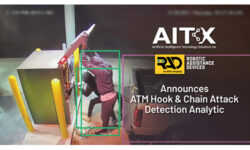Defending Against Next-Gen AI Devices
The ever-increasing capabilities and use of AI for everything from convenience to militaristic tasks signifies the stakes have risen for guarding against nefarious actions.

Using strong digital encryption and cybersecurity best practices must always be top of mind in the shadow of defending against the formidable capabilities and power of AI. Image: tanatpon/stock.adobe.com.
We’ve talked about robots and how they can take over the world. We’ve seen apocalyptic movies and novels that pit man versus machine in epic fights of good versus evil. Current geopolitical and environmental issues have evolved in maturity and capability where cyber defense/and cyber offensive strategies are being used not only in military confrontations, but corporate boardrooms as well. As we think about the current cryptocurrency meltdown, economic and supply chain instability, we face a new dimension of threats that require rethinking and developing new out-of-the-box concepts to identify and defeat adversarial technologies.
Consider artificial intelligence (AI) and what a long way it has come during the past five years. Attending the ISC West show at that time, one encountered manufacturers and security integrators that touted capabilities within video surveillance and access control products with proactive detection and video analytics that were AI-based.
At that time, clarification and contrast examples were needed to understand AI from cognitive learning, decision support, deep learning, neural networks and adaptive reasoning systems — including how they assisted us with gathering useful information, but not really using AI-based systems.
Fast forward, AI became a household technology and industry giants Apple and Amazon (Siri, Alexa) cornered the market with real AI using natural language processing and interpretation. While still flawed in many situations, these products brought real value to the masses and became the cornerstone of prolific advances in AI. The technology advanced from cellphones being recognized as personal data assistants (PDAs) to bringing to life what is known as virtual assistants.
Today, we see the next emergence of real AI integrated into real-world applications currently led by progressive high-tech firms like San Francisco’s OpenAI. A new set of industry giants — including the defense industrial base, automation specialists, car manufacturers, robotics, help desk/call centers and medical equipment manufacturers — all clamor to develop the next best thing in AI.
There appears to be no end to the possibility of AI diminishing the need for humans to think as we move to the smart machine era. When we develop confidence in AI and integrate it into our daily lives we must also think of the adversarial use of AI and its capability to disrupt and negatively impact our way of living.
A group called the Future of Life Institute has administered a petition supported by major AI tech companies calling for a six-month moratorium on large-scale experiments with AI. While they all claim to promise that their technologies will change the course of civilization, they claim that the industry has not taken the steps to ensure AI is not co-opted into nefarious use and establish foundational rules and standards governing the use of AI and AI-based systems.
Let’s dig deeper into where we find ourselves today and what it portends for the electronic security industry and systems integrators.
What Is Adversarial AI?
Machine learning and AI presents a new cyber-attack surface requiring new skillsets, technologies, and competencies to identify and mitigate cybersecurity risks to public, industry, and the nation.
Cybersecurity efforts aim to protect computing systems from digital attacks, which are a rising threat in the Digital Age. Adversarial machine learning, a technique that attempts to fool models with deceptive data, is a growing threat in AI and machine learning.
The monitoring of AI-based technologies, or adversarial AI, is based on technology that if used for malicious purposes can endanger public safety, health, and national security. Before we go down the path leading to machines that decide to exterminate mankind such as seen in movies like “The Terminator,” let’s talk about real-world examples.
One of the best examples we see today is what is known as deepfake. This refers to the use of AI-based models and computer algorithm capabilities to simulate voice, expressions, facial recognition, and computer vision facial images contextually so that the ability to discern real versus fake is not possible.
AI natural language models that now flood the Internet as chatbots, or bots, have been successfully programmed to alter data and make mistakes in its algorithms in advance of presenting it back to other systems and responses.
Next-Generation Technologies
Without going into a dissertation of how AI is developed, there is a specific process known as training AI. This involves taking a machine algorithm and developing responses that classify how the input is used, processed, and output.
Most AI cyber-attacks on AI frequently use poisoning to train the data and labels to underperform during the deployment. Think of this as data being contaminated, rendering the data collected and processed through the AI system useless.

Making sure that AI is fully and completely aligned to human goals is surprisingly difficult and takes careful programming. Image: sdecoret/stock.adobe.com.
Another type of AI cyber-attack is AI model extraction. This is where there is the intent to steal the AI module and reconstruct the data to respond alternatively to the way it was intended to respond.
At the top of the list for dangerous potential targets of compromised AI are autonomous weapons systems, next brain-computer interfaces (BCI), self-driving vehicles, 3D printing, facial recognition, augmented reality, swarm intelligence, in addition to the already alluded to deepfakes and bots.
Distinctions need to be made between systems referred to as automated versus autonomous. Automated systems perform repetitive processes that reduce human interaction yet are still governed by processes and relationships managed by humans. Autonomous systems (especially those that rely on AI) can adjust and modify outcomes without governance or human interaction.
Defending Against Exploits
Using strong digital encryption and cybersecurity best practices must always be top of mind in the shadow of defending against the formidable capabilities and power of AI. Governing the use of AI by the government, as well as public and private organizations, is not too far off.
The military perspective against weapons of war is to establish international guidance and laws of how, when, and under what conditions AI can be used in conflict.
The U.S. Department of Defense’s “Unmanned Systems Integrated Roadmap” sets out a concrete plan to develop and deploy weapons with ever-increasing autonomy in the air, on land, and at sea in the next 20 years. A defining feature of these autonomous weapons systems (AWS) is precisely their ability to operate autonomously: “robotic weapons … once activated, can select, and engage targets without further human intervention.”
As we seek to have greater nonmilitary privacy controls and protection of personally identifiable information (PII), there are specific methods that can be implemented to secure and train AI models. One such process is known as Privacy Preserving Machine Learning (PPML). Another involves code obfuscation techniques that incorporate face blurring with computer vision recognition models.
Making sure that AI is fully and completely aligned to human goals is surprisingly difficult and takes careful programming. AI with ambiguous and ambitious goals are worrisome, as we don’t know what path it might decide to take to its given goal.
One thing is certain … we saw it coming!
Darnell Washington is President and CEO of SecureXperts.
If you enjoyed this article and want to receive more valuable industry content like this, click here to sign up for our FREE digital newsletters!

Security Is Our Business, Too
For professionals who recommend, buy and install all types of electronic security equipment, a free subscription to Commercial Integrator + Security Sales & Integration is like having a consultant on call. You’ll find an ideal balance of technology and business coverage, with installation tips and techniques for products and updates on how to add to your bottom line.
A FREE subscription to the top resource for security and integration industry will prove to be invaluable.







